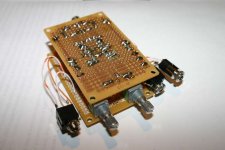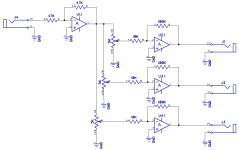Howdy everyone,
So, I built a simple little headphone distribution amplifier. It's based around two OPA4227's (a lovely chip, incidentally - why do stereo opamps put V+ on the opposite side to Pin 1?). I could knock up a full schematic if anyone wanted it, but it's a pretty standard sort of topology, consisting of:
- An inverting buffer
- Output split to two volume pots, each of which feeds
- An inverting gain stage with a gain of 10
- And finally, the two outputs.
The gain stage needs to be inverting so the volume pots don't interact with each other. The buffer is thus made inverting to restore the original phase.
Those counting will find that I have two opamps remaining, so each of the two outputs was given its own actively driven ground "channel".
So, I built a simple little headphone distribution amplifier. It's based around two OPA4227's (a lovely chip, incidentally - why do stereo opamps put V+ on the opposite side to Pin 1?). I could knock up a full schematic if anyone wanted it, but it's a pretty standard sort of topology, consisting of:
- An inverting buffer
- Output split to two volume pots, each of which feeds
- An inverting gain stage with a gain of 10
- And finally, the two outputs.
The gain stage needs to be inverting so the volume pots don't interact with each other. The buffer is thus made inverting to restore the original phase.
Those counting will find that I have two opamps remaining, so each of the two outputs was given its own actively driven ground "channel".
Attachments
The power supply section is provided by a TLE2426 along with a 470uF capacitor from each rail to the virtual ground.
The "sandwich" construction I employed makes it hard to see what's going on, but here's a pic down the side that gives a bit more of an idea.
The "sandwich" construction I employed makes it hard to see what's going on, but here's a pic down the side that gives a bit more of an idea.
Attachments
could it be anything to do with the 741 being able to be reversed in it's socket and survive. This might have been very important in the early days before we all became familiar with ICs.TheSeekerr said:incidentally - why do stereo opamps put V+ on the opposite side to Pin 1?).
any thoughts on whether you could have multiple sources "mixing" into each channel of output?
I'm looking for a monitor mixer for headphones, multiple inputs with individual control for each output
example- recording 4 piece band with vocals- drummer wants more bass and vocals, keyboardist wants guitar, a little more bass, and vocals, but less drums, guitarist wants more guitar and vocals with everything else equal in the background, bass player wants more kick drum and vocals
Peavey used to make a monitor mixer for just such monitor mixes, but they were big boards, each instrument came into the board and there were 8 level controls each sending to 8 'sub masters' so the outputs could send a different mix to a possible 8 monitors... I want something similar (4 sub mixes would be fine) for headphones. Unlike a standard analog mixer with sub buss out the monitor mixers had greater control-
I'm looking for a monitor mixer for headphones, multiple inputs with individual control for each output
example- recording 4 piece band with vocals- drummer wants more bass and vocals, keyboardist wants guitar, a little more bass, and vocals, but less drums, guitarist wants more guitar and vocals with everything else equal in the background, bass player wants more kick drum and vocals
Peavey used to make a monitor mixer for just such monitor mixes, but they were big boards, each instrument came into the board and there were 8 level controls each sending to 8 'sub masters' so the outputs could send a different mix to a possible 8 monitors... I want something similar (4 sub mixes would be fine) for headphones. Unlike a standard analog mixer with sub buss out the monitor mixers had greater control-
post4.
Do you realise that u1 is trying to drive a load just slightly higher than 1k1?
That will need to be a mighty opamp to perform well with that load.
A gain of 10 for a headphone seems far too high.
Do you realise that u1 is trying to drive a load just slightly higher than 1k1?
That will need to be a mighty opamp to perform well with that load.
A gain of 10 for a headphone seems far too high.
Depends. I found my Sennheisers (300 ohm) need some gain from a typical CD player, or from an ipod. Gain of 10 would be more than enough, but it's not 'far too high'.post4.
...A gain of 10 for a headphone seems far too high.
Depends. I found my Sennheisers (300 ohm) need some gain from a typical CD player, or from an ipod. Gain of 10 would be more than enough, but it's not 'far too high'.
it's a bit too high by today's "style".
I have the HD650 and I can live with unity gain.
- Status
- Not open for further replies.
- Home
- Amplifiers
- Headphone Systems
- Simple Headphone Distribution Amplifier


